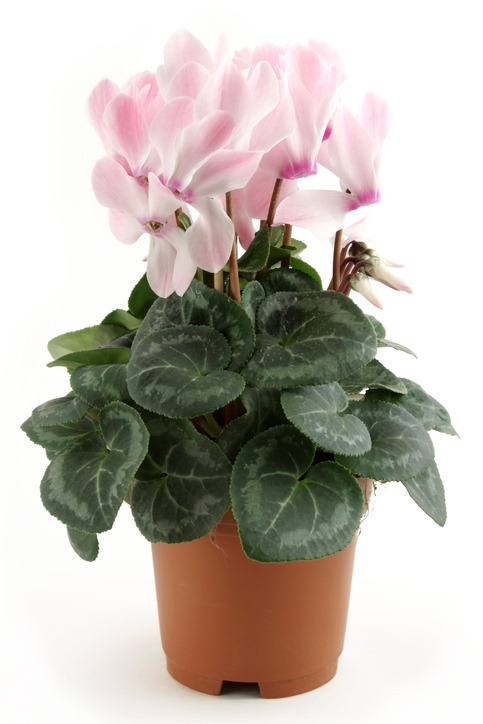Cyclamen
(Cyclamen persicum)
Last
updated: August 3,
2025
Care Sheet List
The Cyclamen
is a popular gift plant, especially during the colder months, known for
its
beautiful, swept-back flowers and marbled, heart-shaped leaves.
They
are unique in that their active growing and blooming season is during
the fall
and winter, after which they go dormant.
Lighting
Cyclamen
prefer bright, indirect light during their active
growing season (fall
and winter).
- Ideal: An east-facing
window is often perfect, providing gentle morning sun.
A few feet back from a sunny south or west-facing window is also
suitable, but avoid direct, harsh sun which can burn the leaves.
- During Dormancy: When the plant
goes dormant in late spring/early summer, it's best to move it to a
cool, dark place.
Watering
Routine
Proper
watering is crucial for Cyclamen, and it’s where many people
go wrong.
They need consistently moist soil but are extremely sensitive to crown
and root
rot.
- Method: The best way to
water is from the bottom. Place the pot in a saucer or dish of
room-temperature water for about 15-20 minutes, allowing the plant to
soak up what it needs. Remove the pot and let
any excess water drain away.
- Frequency: Water when the top
inch of soil feels dry to the touch. You should avoid getting
water on the leaves or the central "crown" of the plant, as this can
cause it to rot.
- Dormancy: As the plant
enters dormancy in spring (leaves yellow and die back), gradually
reduce watering and stop completely once all the foliage has gone.
Water only enough to keep the soil from completely drying out during
this period.
Fertilizer
Requirements
Fertilize
your Cyclamen sparingly during its active growing and blooming season,
from fall
through spring.
- Type: Use a balanced
liquid houseplant fertilizer or a "bloom booster" fertilizer slightly
higher in phosphorus.
- Commercial Recommendation: Miracle-Gro
Indoor Plant Food (Liquid) or Schultz Liquid Plant
Food are easily available options. Dilute these commercial concentrates to achieve approximately 25-50 ppm N in your final solution. This is often equivalent to using them at "half strength" of the package's recommended dose.
- DIY Fertilizer Suggestion: For optimal blooming, use your homemade 1-2-1 liquid fertilizer concentrate (High Phosphorus) or a balanced 1-1-1 liquid fertilizer concentrate.
- For 1-2-1 concentrate (10,000 ppm N): Apply at a "Light Feeding" rate, using 5 ml per 1 liter of water (resulting in ~50 ppm N, 100 ppm P₂O₅, 50 ppm K₂O). See recipe details.
- For 1-1-1 concentrate (10,000 ppm N): Apply at a "Light Feeding" rate, using 5 ml per 1 liter of water (resulting in ~50 ppm N, 50 ppm P₂O₅, 50 ppm K₂O). See recipe details.
- Avoid: Do not
fertilize when the plant is dormant.
Over-fertilizing can lead to lush foliage but fewer flowers.
Misting
Requirements
Cyclamen
prefer cool temperatures and high humidity.
- Recommended: They appreciate
a humid environment, especially in winter when indoor air is dry.
- Methods: Placing the pot
on a pebble tray filled with water is an excellent
way to provide humidity without getting the foliage wet.
You can also use a room humidifier nearby. Misting the foliage directly
is not recommended, as it can encourage fungal diseases and rot.
Pot Size
and Soil Type
- Pot Size: When repotting,
choose a pot that is only 1-2 inches larger in diameter
than the current one. Cyclamen grow from a
corm (a tuber-like structure), and it's best to plant it so the top of
the corm is slightly exposed above the soil line to prevent rot.
Ensure the pot has excellent drainage holes.
- Soil Type: Use a well-draining,
slightly acidic, and organically rich potting mix. A standard
houseplant potting mix amended with some peat moss and perlite works
well. The key is a mix that holds some moisture but allows excess water
to drain away quickly.
Special
Notes:
- Temperature: Cyclamen thrive
in cool temperatures, ideally between 50-65°F
(10-18°C) during the day and slightly cooler at night.
Avoid placing them near heat vents, radiators, or hot windows.
- Dormancy: Do not discard
your plant when the leaves yellow and die back in the spring! This is
its natural dormant period. Reduce watering, store the pot in a cool,
dry, dark place for the summer, and resume watering in the fall when
new growth emerges.
- Deadheading: To prolong
blooming, remove spent flowers and yellowing leaves by twisting the
stem and pulling it cleanly from the base of the plant.


